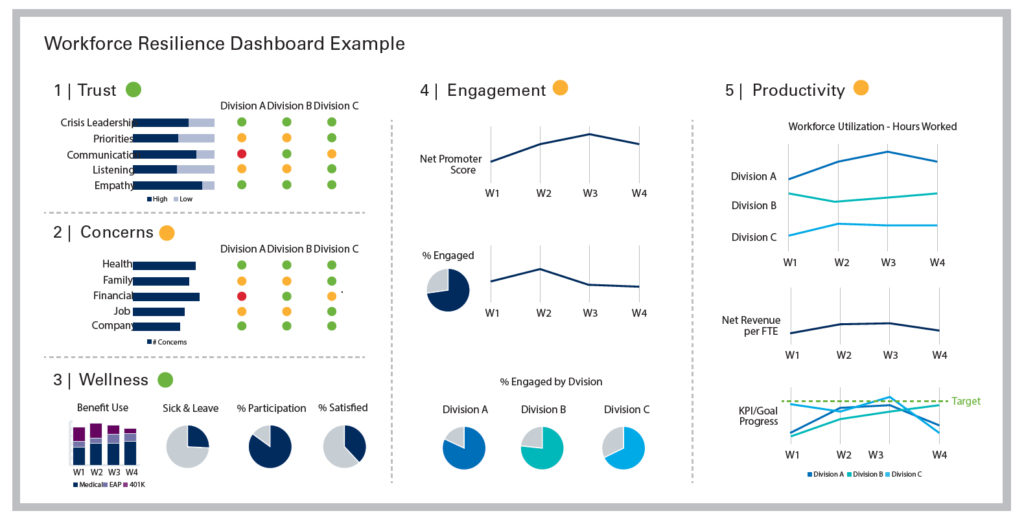By Tony DiRomualdo and Harry Osle
During the coronavirus pandemic, and for months afterwards, businesses and their workforces will be subject to immense strain. It is important that organizations be vigilant about maintaining workforce well-being and productivity throughout this period. HR should lead the charge by identifying and proactively monitoring key indicators of the physical and emotional state of employees and staying on top of issues that could impact their resilience.
While there is no standard set of measures that can be used by all organizations, we believe the categories laid out below apply fairly universally. HR organizations are likely to be tracking some of these already, but others will need to be added to the mix. Further, some metrics will be easy to capture, while others might only be gauged via proxies. The goal is to be able to flag potential problems early and quickly respond to prevent long-lasting damage.

Collect Data by Listening and Sensing
Gathering indicators of workforce resilience requires a variety of data collection methods such as tracking polls and pulse surveys. Start by identifying relevant measures already being monitored (e.g., hours worked, sick time and leave taken). Look for other data that can be gathered and analyzed via automated tools such as analysis of logged employee inquiries to HR websites and help lines.
Additionally, methods such as sentiment analysis of social media (external sites, such as Glassdoor and internal apps like Slack, Yammer, etc.) and e-mail communications should be applied to identify patterns across the workforce. HR leaders can also set up easy-to-access feedback channels for employees so they can share their concerns with colleagues and leaders.
Below are five categories of resilience drivers HR should be tracking and examples of specific indicators that might be used to capture relevant data for measurement:
1. Employee Trust in Leaders
Employees will be able to endure job stress better if they believe leaders are being truthful, empathetic and doing everything they can to help in this difficult period. Confidence and trust levels of employees can’t be measured precisely, so they must be gauged via proxy metrics, i.e., data representing perceptions about how much employees trust their leaders. HR needs to be on the lookout for any policies, communications or behaviors which may be undermining employees’ trust.
Below are some aspects and drivers of trust in leadership that should be tracked:
- Confidence in leaders’ ability to steer company through crisis: Level of faith that the workforce has in the abilities of their leaders.
- Believe leaders have the right priorities: They are able to fairly balance the interests of all stakeholders.
- Believe leaders communicate clearly and honestly: They convey information in straightforward and understandable ways and are perceived to tell the truth both good and bad.
- Believe leaders truly listen to employees: A safe space exists for open dialogue; leaders listen to and acknowledge what others have to say.
- Believe leaders have empathy for employees: They understand employee concerns and will do as much as possible to support them.
2. Employee Concerns
Employees’ anxiety about jobs and personal lives is sure to remain high in the coming months. Tracking their concerns will help HR get a handle on how well programs are working and identify areas in need of improvement. Where possible, use pulse surveys and focus groups to gather this data directly. Look for clues about employee concerns by monitoring help-line queries, internal communications and social media. The following are suggested categories of employee concerns that might be tracked:
- Health: Issues related to workplace health risks and general concerns regarding the coronavirus and other health issues.
- Family: Issues and concerns related to children, spouses and other family members, including their health and how they are adjusting to changes in working and care arrangements.
- Financial: Issues and concerns about the impact of events on their current and future financial well-being; confidence in financial security.
- Job-related: Perceptions about their ability to do their job under current working conditions; concern over job risks.
- Company-related: Perceptions about how the company is faring and its ability to survive the crisis.
3. Employee Wellness
HR should monitor employee wellness closely with the goal of ensuring programs and assistance are being put to good use. It is essential to identify emerging issues and gaps in support that need to be addressed. At a minimum, measure the overall health of the workforce (e.g., tracking sick time taken, benefits usage and inquiries to help lines). There are several potential indicators of employee wellness that can be monitored:
- Health and medical benefits used: Changes in volumes and types of benefits accessed.
- Sick time and leave used: Changes in volumes of sick time and leave usage.
- Use of wellness programs/benefits: Degree to which stress management, mental health/counseling, alcohol and substance-abuse programs are being used; self-reporting of how people are feeling and causes of stress.
- Maintenance of healthy behaviors: Continued/new participation in available employee wellness programs offered (self-reported).
- Satisfaction with wellness programs: Degree to which these are meeting the changing needs of employees.
4. Employee Engagement
While the crisis endures, expect employee engagement levels to take a hit. HR needs to closely monitor overall engagement as well as the factors driving or detracting from it. This means staying on top of employee perceptions about the company’s outlook, leaders and immediate supervisors, as well as their jobs. Any significant changes in perceptions about these are warning signs that engagement may be slipping in ways that will hurt organizational resilience. Track high-level indicators like overall engagement level and net promoter score. Or, consider delving more deeply via pulse surveys or sentiment analysis of internal media to gauge the following:
- Feelings about the organization: Strength of belief in the organization mission and strategy.
- Feelings about leaders: Trust and confidence in the organization’s leaders.
- Feelings about immediate supervisor: Perceptions about guidance and support from direct managers.
- Feelings about team: Feelings about the quality of interactions, collaboration and work with team members
- Feelings about job: Perceptions of the ability to do the job and levels of satisfaction with the work performed
5. Employee Productivity
Ultimately, the performance of employees – work conducted, outputs produced, objectives reached, results achieved – will depend on how well the other factors discussed above are managed. The better workers are supported, the more likely performance levels can be sustained. HR organizations with experience tracking drivers of performance will have already identified those that correlate most strongly to performance. These factors warrant close monitoring, especially any that are leading indicators of performance:
- Hours worked: As reported by time and attendance systems.
- Individual KPIs/objectives: Measures of individual work outputs and progress toward goals.
- Team KPIs/objectives: Measures of teamwork outputs and progress toward goals.
- Business unit KPIs/objectives: Measures of business unit operational and financial performance and progress toward goals.
- Enterprise KPIs/objectives: Measures of enterprise operational and financial performance and progress toward goals.
Conclusion
Many companies have responded swiftly and effectively to the impacts of the coronavirus pandemic as it has played out so far. But this is only the initial phase of the crisis; a longer and potentially more difficult period is now unfolding. To make it through, organizational leaders, guided by HR, must make workforce resilience a top priority. This will require closely tracking the drivers of employee well-being and acting decisively to further support the workforce as long as needed, so it can emerge from the crisis in as healthy and productive a state as possible.

Harry Osle, Principal in Charge
Global Human Resources
Practice Leader
The Hackett Group

Anthony DiRomualdo, Senior Research Director
Global Human Resources
Executive Advisory Program
The Hackett Group
